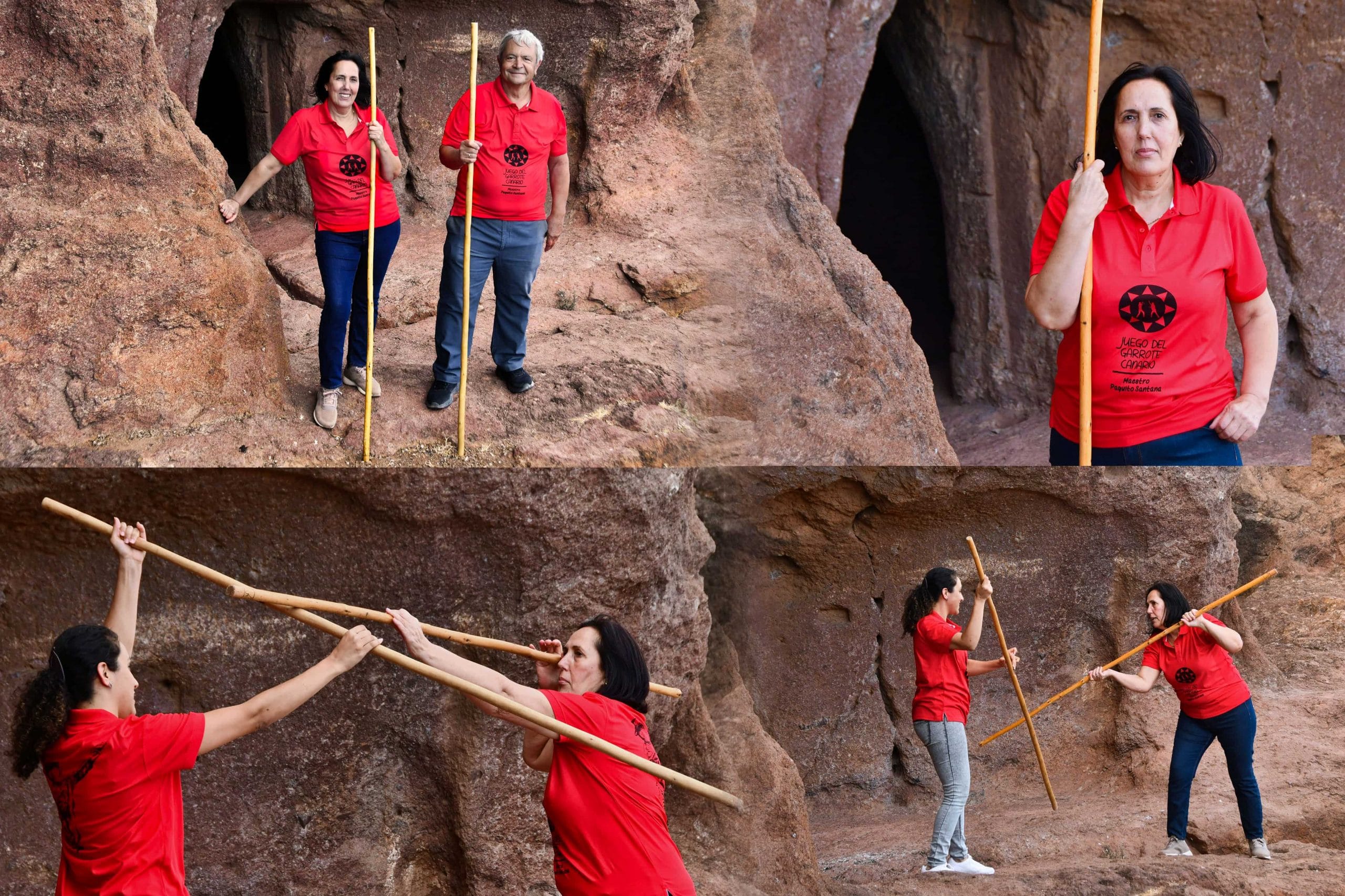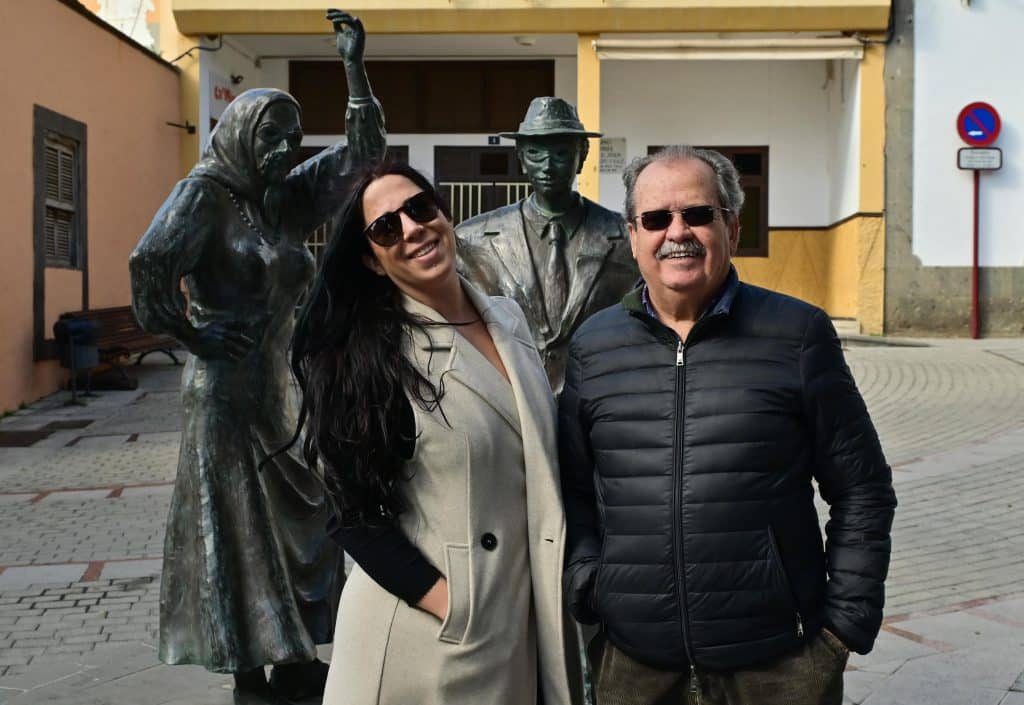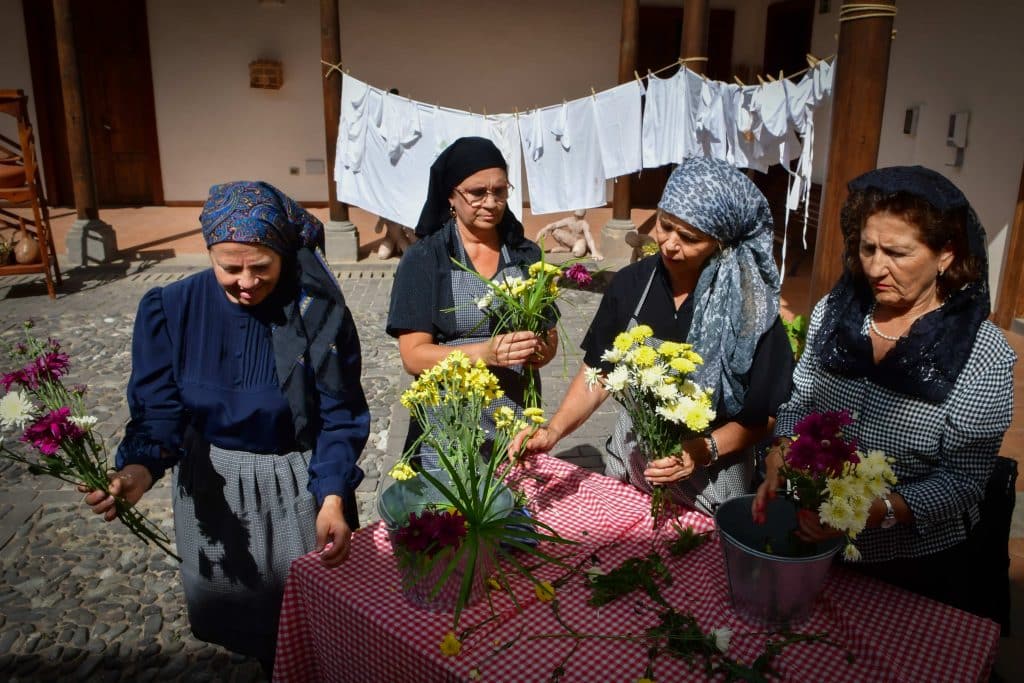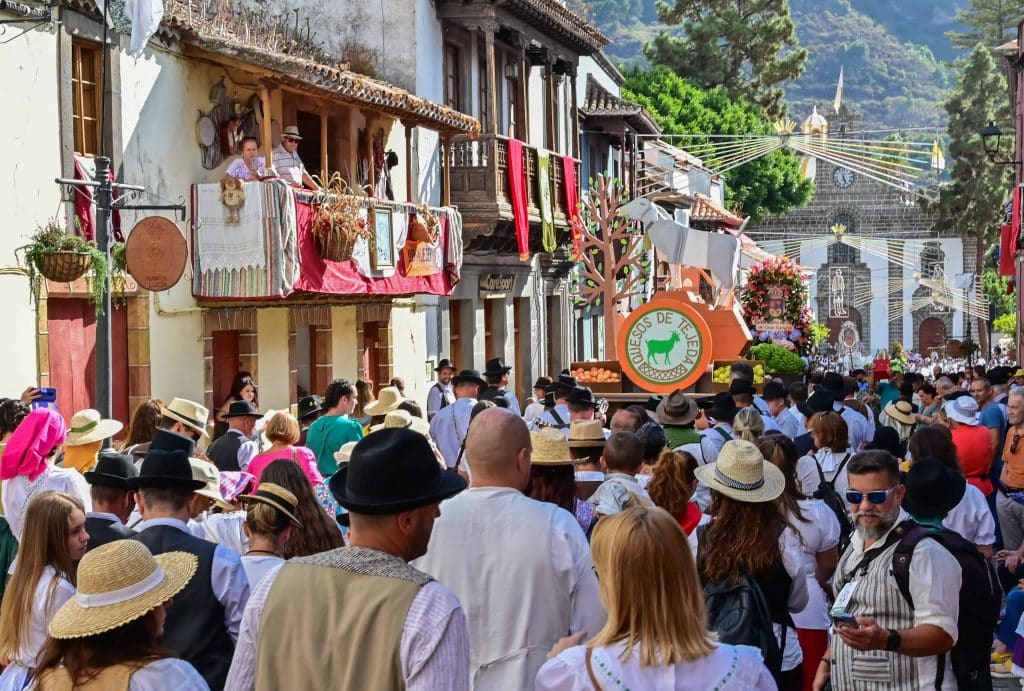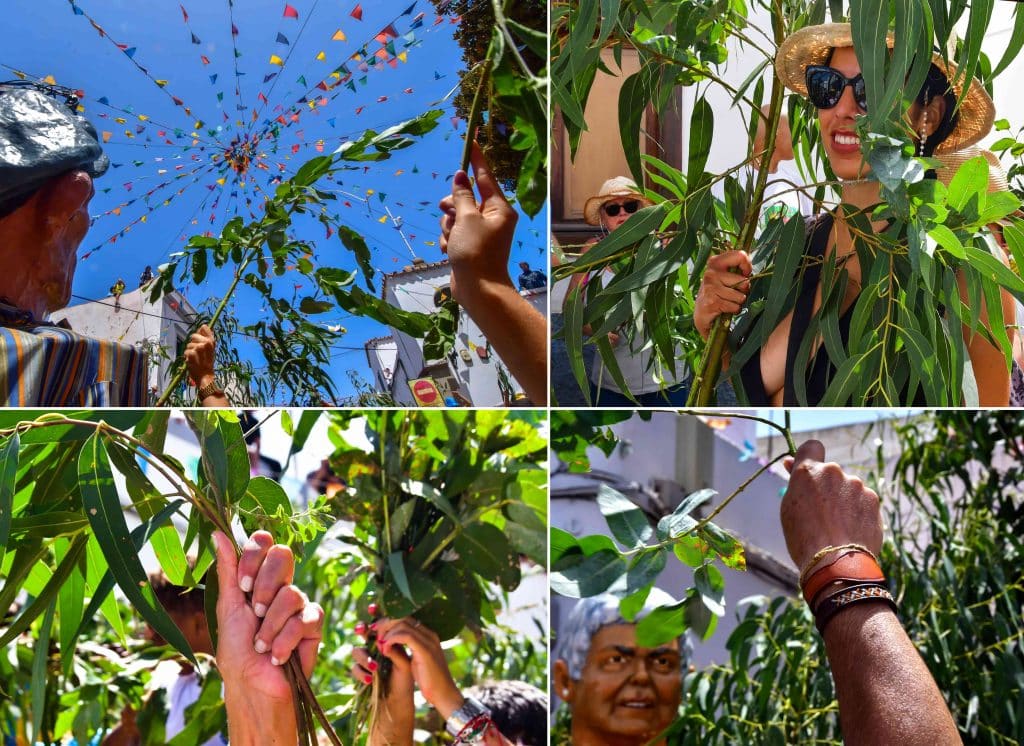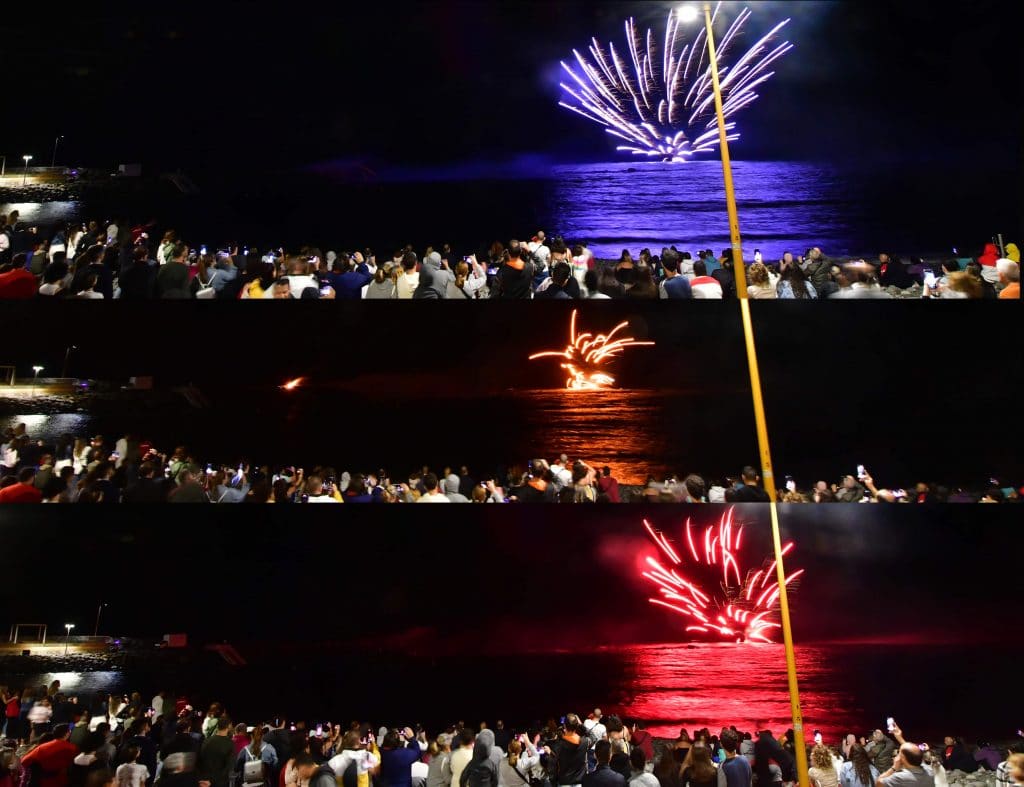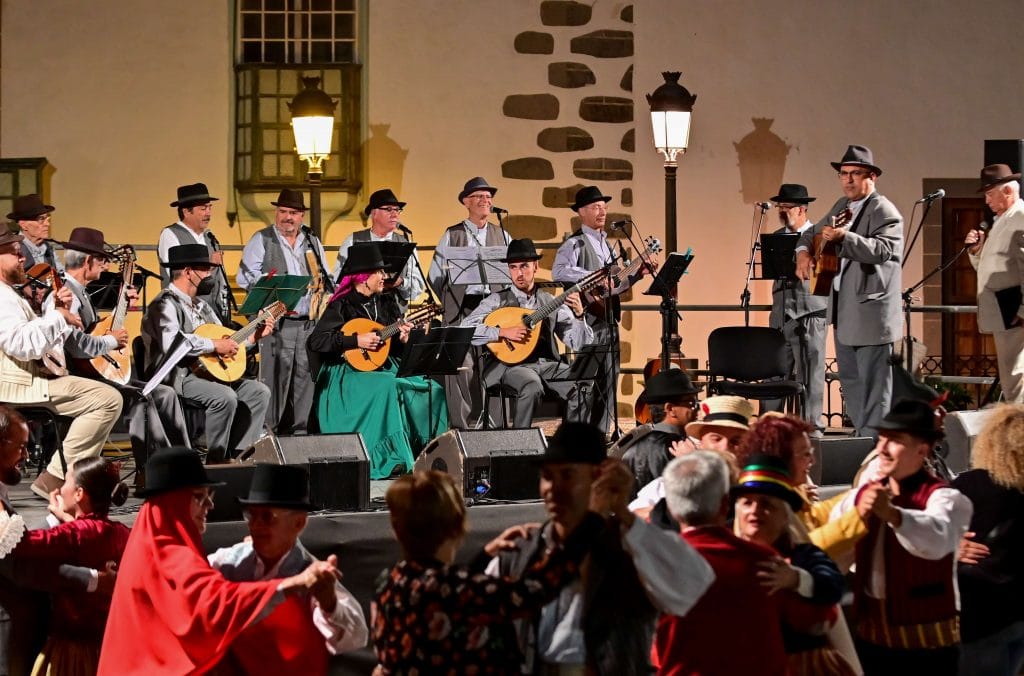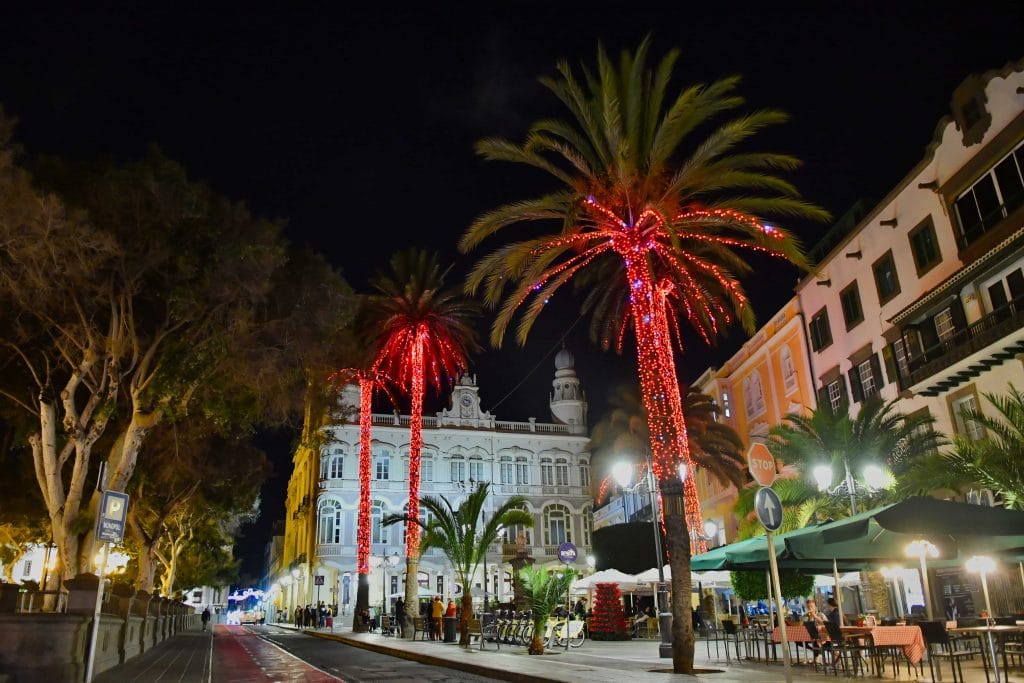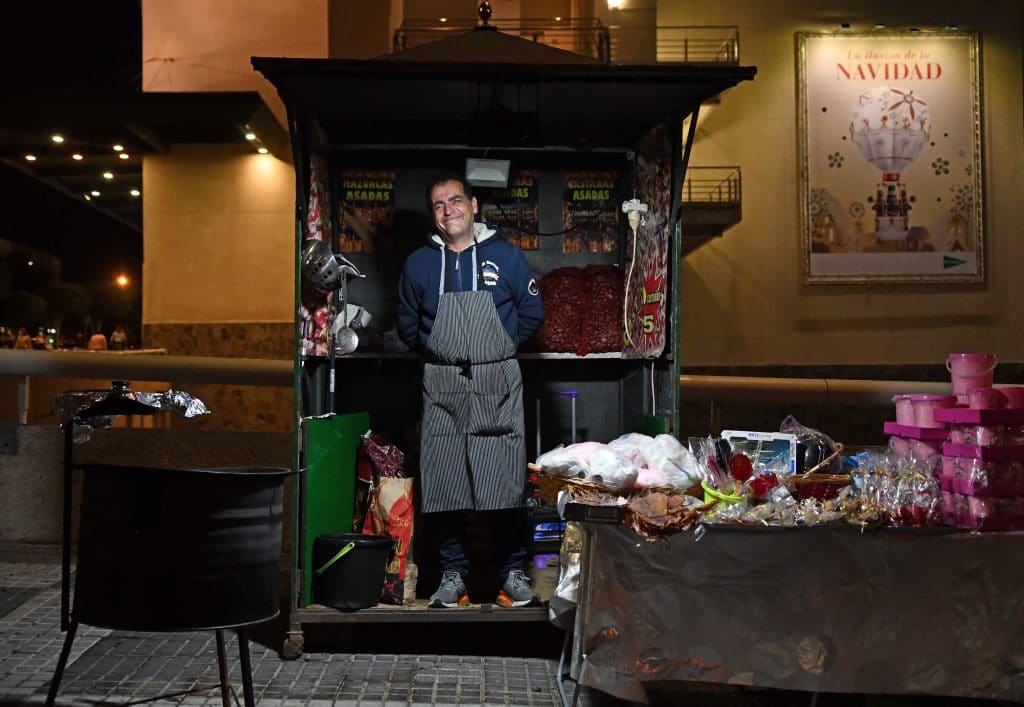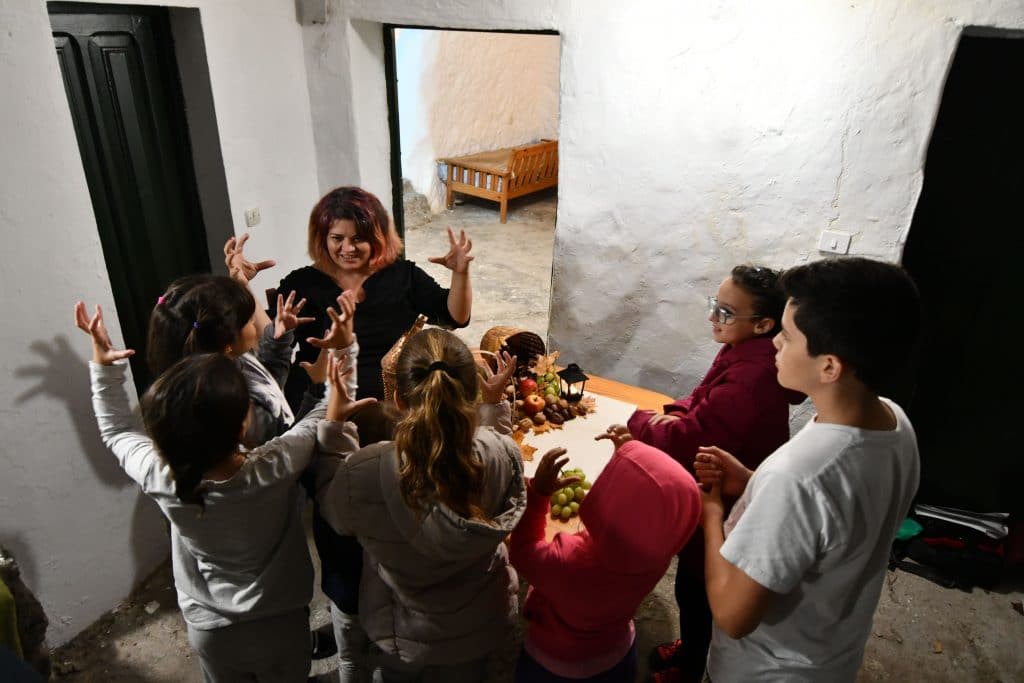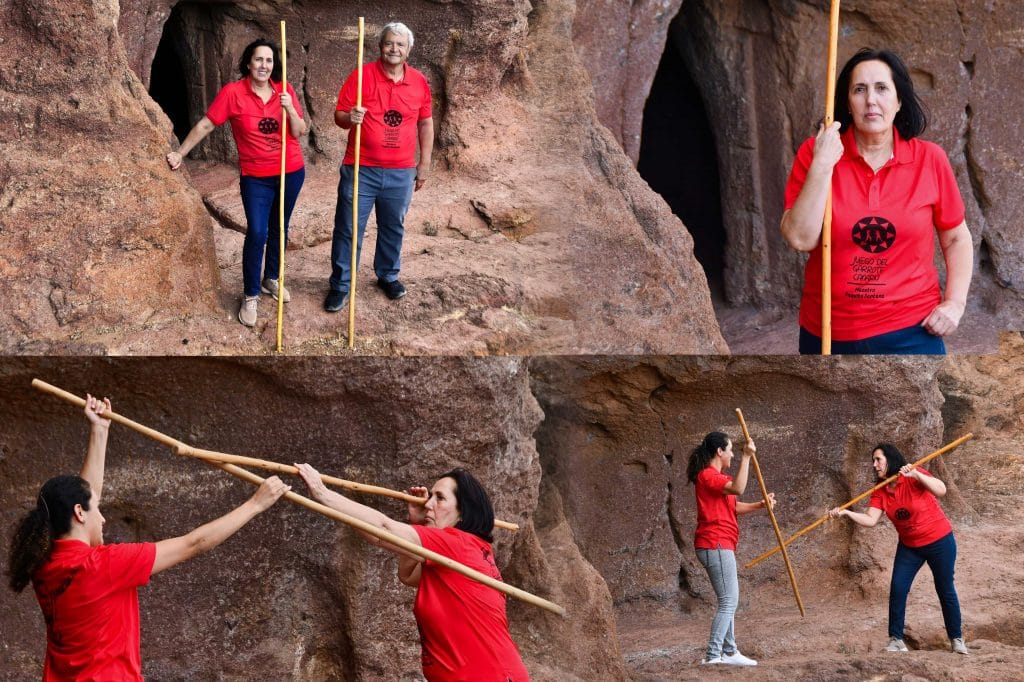At the Cuatro Puertas Site (Montaña Bermeja, Telde), which keeps the history of our ancestors among its volcanic tuff, the Canarian clubs sound.
Ana Rosa Santana and her husband Eladio Santana, companions of life and passion for this ancestral art, keep the Canarian Garrote Game alive. Ana Rosa tells us about her work at the Lomo Cementerio school (Telde).
We continue with the legacy of my father, teacher Paquito. We give classes on Tuesdays and Thursdays, from 6 to 9 in the afternoon and for anyone who wants to learn it is free. Girls and boys come, they try it and over time they come back wanting to learn more and practice.
How many styles of playing Garrote are there currently?
My father had a good group of people learning with him, this led to other schools with his style like La Barranquera. There is also the Reboliá, in Santa Lucía, who play it a little differently.
There are those who adapted the game to teach the police and introduced other things, mixing the game with martial arts. This, even if it is a game, is not of the Stick / Garrote.
There are also other people who are not federated but are teachers and give classes. The important thing, when you transmit the culture, is to be serious and play demonstrating sports values and setting an example.
What requirements are necessary to start in the game of the Garrote?
For children, I like that they are over 7 years old. It is good for everyone. For the spine, for the arms ... anyone can play.
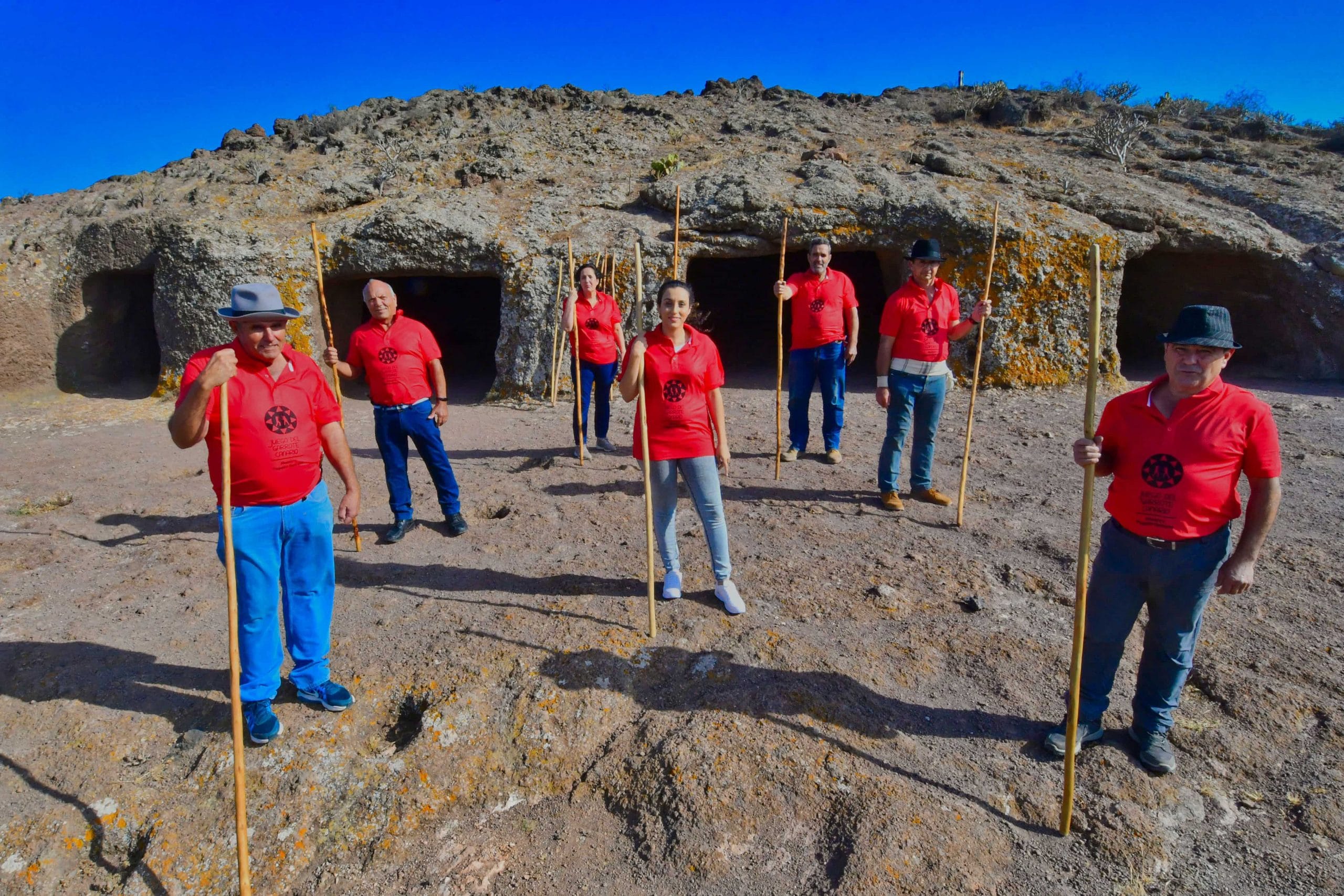
What is the first thing that is taught?
It begins by teaching how to handle the Cudgel: grasp it with both hands, know how to change hands and defend the head.
Come to explain. I teach this to the children- Ana begins to move the stick skillfully but also slowly, with mastery-5 points are taught to play with the stick. And always the head defended. At first it bothers the arms a bit, but it passes quickly.
Do you have to buy a stick?
No need, we lend them to play at school.
Are they in contact with other groups that play Palo, on other islands?
Sure. We have a very good relationship with everyone. We hold national meetings, although it was not held last year, due to the health situation. The meetings are open to the public and we see people from all the islands
Is there training in the meetings?
Rather, you can see the teams playing but there are no workshops. The workshops are held on specific days such as Canary Islands Day, local festivals, whether it be San Juan, San Gregorio in Telde. So yes, the public is invited to participate and practice a little. What I like the most is going to schools so that the girls and boys can see and learn the game. Ana is an elegant, serene woman and a lover of Canarian popular culture. And his eyes light up when he talks about the desire he has to go back to teaching minors.
On the islands, are there several modes of the game?
The big stick is only played in Gran Canaria on the long stick. La Vara, which is smaller, is in all the islands and in Fuerteventura there is a long stick called the Lata game.
And the tricks are the same?
The Canarian Club is played on both sides of the stick. -Grab a stick with both hands and raise it horizontally-Come get up: it is played by touching like this and like this ... Touch me now, shoulder and shoulder, foot and foot ... touch touch, touch touch ...
Then there is the small Rod -Eladio shows me one while moving with it - and it has a different movement, you take it as if you were dancing.
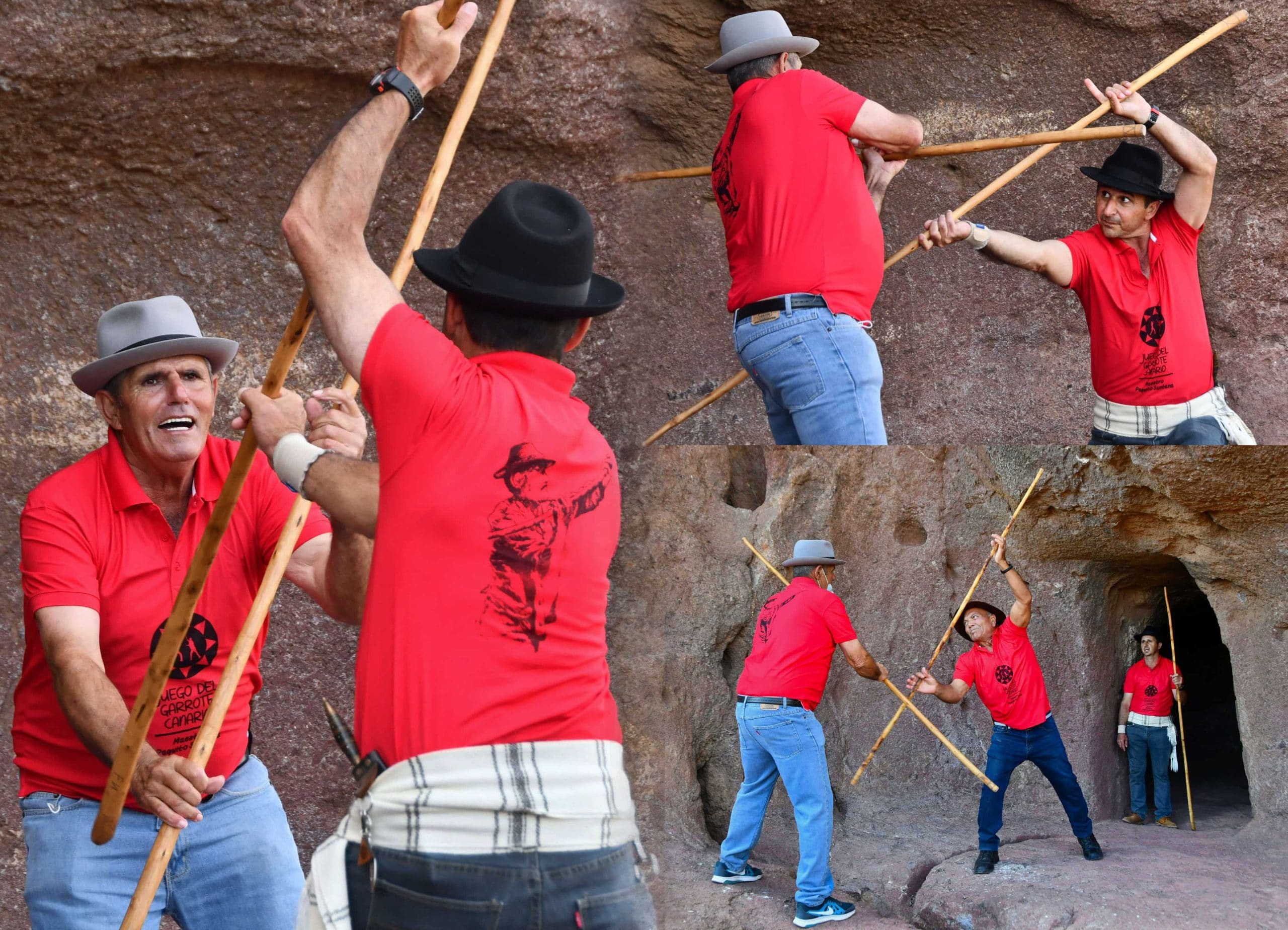
Is El Tolete canary?
It is, rather Venezuelan, it is not a Canarian stick. It is a defense and is believed to be a derivative of a camel wand.
Ana I'm going to tell you a story:
«Once upon a time there was a boy who ran away to the field with the shepherds and they taught him everything they knew ...
That's my father -he laughs and follows the story with affection- Francisco Santana Suárez was born in 1921 and was orphaned by a very small mother. Instead of going to school, he would go with the shepherds who invited him: "Paco, I'm going upstairs to clean the goats." With the shepherds he learned to milk, make a bag, to cure a bad eye on a dog ... And the most important thing is that they also taught him the Game of the Cudgel. "
Among all the pastors, was there a teacher to highlight for Paquito?
Well yes, José Calderín, known as “Pispís”. He was the one who finished training my father.
Didn't women play club?
My father transmitted it to male children, less to women because of the beliefs of that time. Although my sister Araceli learned it very well. And me too, a little. It is said that the mother of "Pispís" who was called Cho Pino, from Valsequillo, was a beast to fight. She played very well.
Is the club the same stick used for grazing?
In essence it is the stick that the shepherd uses to jump and with that same club they defended themselves in ancient times. The shepherds had a boundary and if it was not respected they began to use the stick as a defense and they did not know when they finished, but that was how the problems were solved.
The school is registered as a school for the game of the canary stick and the shepherd's jump.
At what point did teacher Paquito decide to teach it and disseminate it?
He taught the children, as I told you, but one day a boy named Pedro Pérez went to Goro to talk to my father.
-Maestro Paquito, this is going to be lost, it would be a shame, ...
And he told him to teach it to him and a small group of his friends, just as he did with his children. Before long, a lot of people were coming and asking for it. He had more than 50 people learning at the Goro.
Why didn't you teach it before?
Formerly they met where no one saw them, to practice the game. My father taught it at home but not to the general public, because it was something forbidden. In fact, at first he did not want to move this much because he came from many years of prohibition and when he hurt himself playing secretly, if someone asked him he would always make excuses: "What did I fall down the slope, ...", so that they would not discover it .
It was not until 1982 that teaching outside of our home began little by little.
But you also investigated and disclosed, right?
The first association of the palo canario helped my father to make this known. After teaching at the Goro, he had students at the Lomo Cementerio, at the López Socas in Las Palmas de GC and went wherever there were interested people.
He began to travel all over the islands making known what he knew about the stick, teaching and also looking for people to play it. This is how he found Lata, la Vara ... he discovered that the Garrote was only in Gran Canaria.
What woods are the sticks made of?
Now the good good is the wild olive. The strongest, hence the saying: "There is no stick to fight with wild olive trees"
Aceviño is also used, which we bring from Tenerife and eucalyptus that comes from Moya ... He shows us some clubs and among them a very endearing one. This is the last stick my father had in hand. Look at what a beautiful color.
Who makes them?
Ourselves. It is cut into a last quarter because there is less sap on the tree and it is left a year or two to dry. You try to choose the segment that is more straight, so as not to have to give it a lot of fire.
Is it given fire?
Formerly it was with a fire made with gorse and the stick was passed over it carefully. This is how it also straightens, with fire and a carpenter's lashing, with patience and tranquility so that it does not break. The bark is removed and then it is sanded a little, it can be with a glass and at the end we put mutton tallow that the shepherds get us.
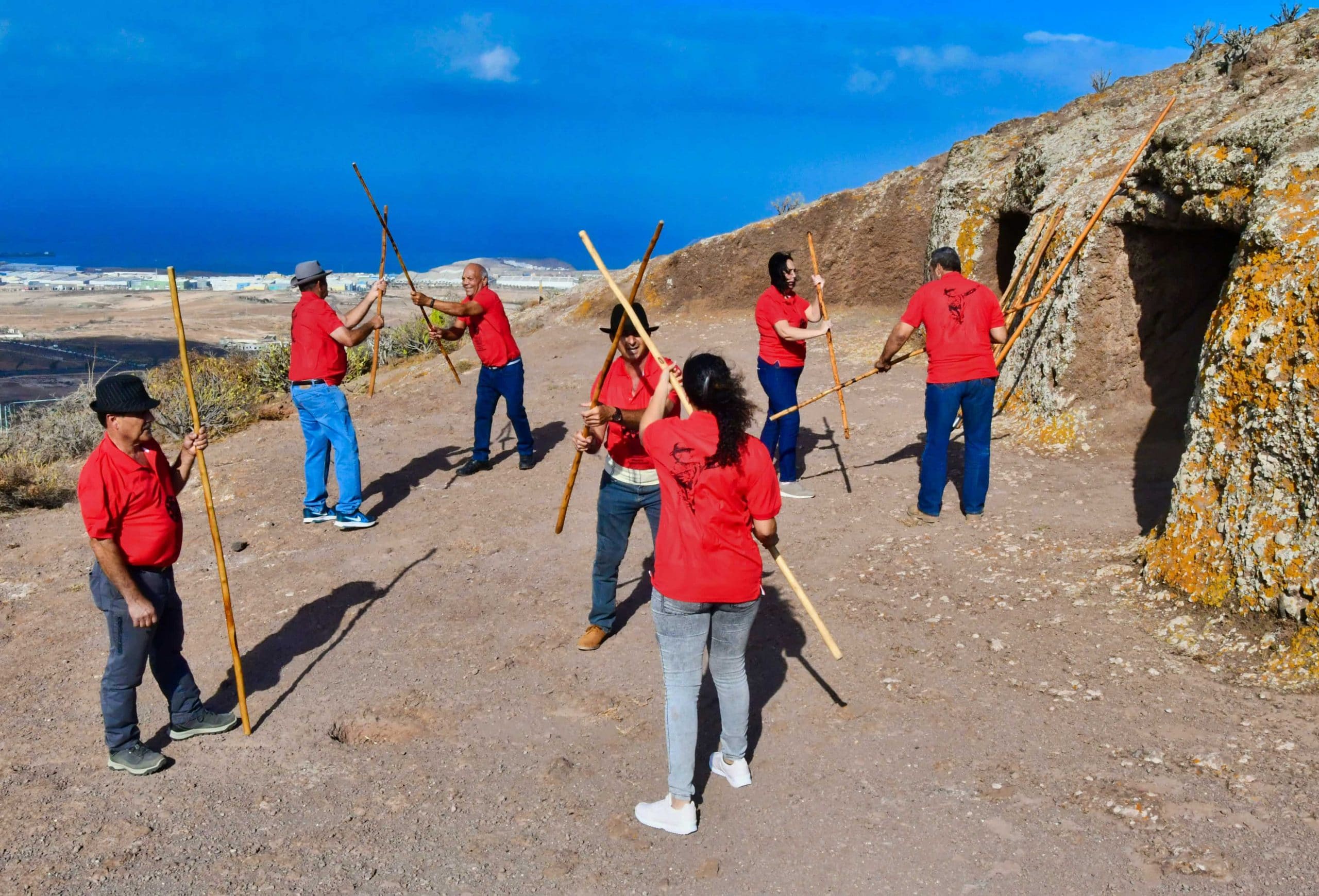
What maintenance does the club take?
The maintenance it takes is to put mutton tallow once a year, when the stick is dry and that's it.
How long does the stick last?
Forever. Look at my father's. It's new.
When you hear the sound of the sticks while others play, what do you feel?
The sound of the stick moves me, I was always a father and I feel like pride when someone learns, because it is something very ours and for following the path that my father marked. This is our essence and it would be a shame if it were to be forgotten. I am not a teacher, what I have is interest for this to continue. A thing that is so beautiful when you play and also when you watch. In addition to knowing that our ancestors used them to jump, to defend themselves.
Your father has a monument in El Calero, how do you remember that day?
«My father was gone. I remember and it moved me -sighs- and I am grateful because in 2019 the Telde City Council gave all the facilities and the FEJUPAL (Federation of the Palo Game), held a national meeting in Telde where we really enjoyed remembering it.
In 1985 at the Pérez Galdós Theater, he was named the best native Canarian athlete. They paid him a tribute. My father was fortunate that all his work in life was recognized.
Apart from visiting schools to plant seeds, what other next objective does the “Family of Maestro Paquito Santana” have?
May this tradition continue to be passed on. We, together with our colleagues from “La Barranquera” and “La Reboliá”, have presented a petition for this to be declared an Asset of Cultural Interest. We have recently registered it.
We got a space to play, in Lomo Cementerio, and that was progress, because we were on the street and thanks to the venue we trained properly.
As an extracurricular activity, it occurs in schools in Telde and Santa Lucía. The good thing would be for it to happen in all municipalities and in all schools. We bet on this because if the youth know it, they stay playing. This like.
Any appeal for all that Canarian youth?
Here I invite people to go to the place and try it, that this comes from very old and is something unique. It is our history, our customs ...
“Enjoying this game live is a mesmerizing experience. As you go you realize that whoever plays also enjoys. The melody of the clashing of the Canarian clubs has accompanied us from very distant times. We wish to see clubs in all the schools of the Canary Islands paying tribute to the legacy of Maestro Paquito, his family and our ancestors. »

